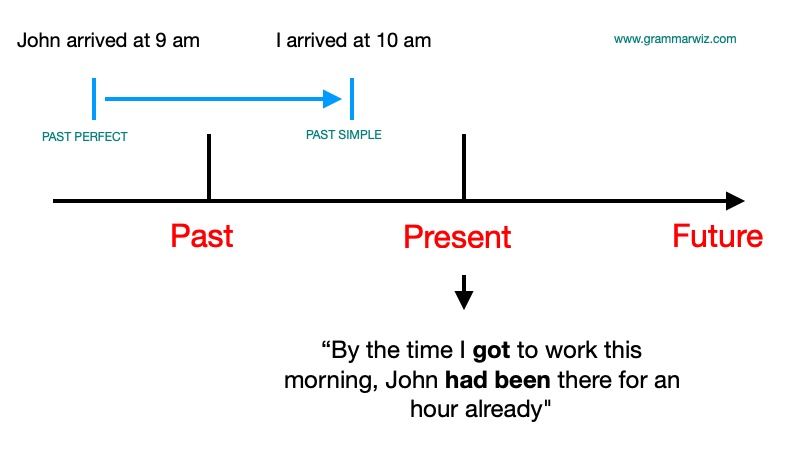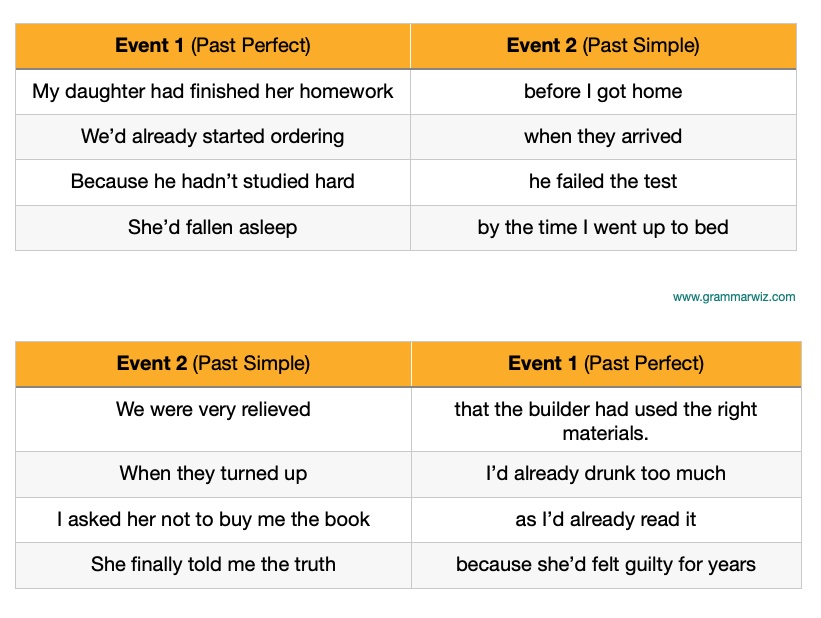When to Use the Past Perfect Tense
It can be difficult for learners of English to know when to use the past perfect tense. It's basic function is to make it clear that one event happened before another in the past.
It's created by using:
had + past participle
They had eaten all the food
It's often used alongside the past simple. The example below illustrates why you would choose to use the past perfect in certain situations.
Example:
Imagine that you arrive at the office at 10am. John is already there and tells you he has been there since 9am.
So you think, "Oh, John has been here since 9am".
You use the Present Perfect at this point as it's something that started in the past but is still ongoing or relevant to the present (he's still there).
When you get home you want to tell your wife, so you say: "By the time I got to work this morning, John had been there for an hour already".
You are now talking about one event (John arriving at work) happening before another event (you arriving at work), and you are describing this whole scenario at a later time, so they are both past events.
Event 1 is the past perfect tense and event 2 is the past simple.
You should be able to see from this that the past perfect achieves two main things:
- To show time from one point up to another point in the past
- To show how one action happened before another action
This can also be illustrated well in a time line:
Examples of the Past Perfect
These examples of the past perfect show you how it can be used to describe two events in the past, where one occurred before the other. You'll see that we can put the events in a different order but the first event always uses the past perfect.
View more examples of the past perfect >>
Making Negative Sentences and Questions
Negative
To make past perfect sentences negative, we simply add 'not' after 'had':
- She hadn't (had not) prepared anything before I arrived
- Ian arrived at 6, but I hadn't had a chance to tidy up
Questions
And for yes/no questions, we use 'had + subject + past participle':
- Had she prepared anything before you arrived?
- When Ian arrived, had you had a chance to tidy up?
For other question words (e.g. why, when, how long), these are placed before 'had':
- Person 1: When I arrived, Susan was there already
- Person 2: How long had she been there?
Common Past Perfect Time Expressions
These are some common time expressions used with the past perfect. You'll commonly see these same time expressions with all the perfect tenses.
Just
- She had just left when I got there
- We'd just booked the holiday
Already
- They had already taken the bins out
- The police had already arrested him by the time I got there
For
- She had been there for two hours
- I'd worked there for 7 years before they decided to offer me a promotion
Yet
- I got there at noon but the others hadn't arrived yet
- I hadn't yet seen the changes in her I wanted to see
Before / After
- I'd worked there for 7 years before they decided to offer me a promotion
- After I had been promoted, I got more responsibilities
When
- She had just left when I got there
- When we'd completed our homework, we went out to play
By the time
- We had ordered our starter by the time they turned up
- By the time he got there, we had already left
Until
- We couldn't start the meeting until everyone had arrived
- Until he'd tidied his room, I refused to let him go out
Note that when, before, after, by the time, and until are all conjunctions that make up complex sentences (adverbial clauses in this case) and the clauses can be placed in either order. For example:
- She had just left when I got there
- When I got there, she had just left
The past perfect and past simple though are not only linked with these words, and can be linked with words such as 'because', 'that' and 'so'.
View more examples of past perfect sentences >>
Other Uses of the Past Perfect
Conditional Expressions
Another time when we use the past perfect is to make up one of the two clauses in the third conditional. The third conditional is used to imagine present or future situations that in reality are unlikely or impossible to happen.
It has two clauses joined together, in either order:
- If + past perfect
- would + have + past participle
Past Perfect in the 3rd Conditional:
- If we had taken the train, we would have been there much earlier.
- Mike would have passed the test if he'd bothered to revise for it.
- She wouldn't have been tired if she'd gone to bed at 10pm.
You'll note that this is still two events, with one happening before the other, even though the events didn't actually happen as they are imagined i.e. if we had taken the train (event 1 - taking the train) we'd have been there earlier (event 2 - arriving earlier).
Wishes about the Past
We also use the past perfect to talk about regrets from the past using the word 'wish'.
When we do this we are referring to things that have already happened but we wish they'd happened in a different way. It is, then, similar to the way we can use it for the third conditional.
Past Perfect for Regrets:
- I wish I had travelled more when I was younger.
- She wishes she had bought the dress.
- I wish I'd gone to meet her as I might not see her again for months.
Common Mistakes with the Past Perfect
Using it When Not Necessary
Often with the past perfect, we choose not to use it because the context or the words we are using with it make the sequence of events clear.
This is common with before and after, as those words themselves clarify which event came first. These were the two examples we looked at above:
Using the Past Perfect:
- I'd worked there for 7 years before they decided to offer me a promotion
- After I had been promoted, I got more responsibilities
Using the Past Simple:
- I worked there for 7 years before they decided to offer me a promotion
- After I was promoted, I got more responsibilities
The sequence of event in these two sentences is still clear by using the past simple in both clauses. So it's not wrong to use the past perfect with before and after for sequencing past events, but if it's clear without it, it may well not be used.
No Sequence of Events
Another mistake when using the past perfect is using it when there is no sequence of events. Take a look at this example.
- When I lived in Spain, I had been a chef.
This is two past events but it doesn't involve one event happening before another - they happened at the same time. So it should be:
- When I lived in Spain, I was a chef.
Overuse in Narratives
Another time when we use the past perfect is in narratives. In other words, telling stories.
It's used in storytelling to give background information but main narratives in the past are still mostly in the past simple tense. The past perfect can provide details of events that occurred before the main narrative.
Take a look at this example.
Past Perfect Used Too Much
She had been to Spain before. She had lived there for 4 years and had played in a band while she was there. She had also made many friends during her time there.
Past Perfect Used Correctly
She had been to Spain before. She lived there for 4 years and played in a band while she was there. She also made many friends during her time there.
It's not necessary to keep repeating the past perfect - it looks better with just the past simple. The skill of how much to use it can be complex but would become second nature as you get better at English rather than through analysing it.
Check out more on the past simple for building narratives.
New! Comments
Any questions or comments about the grammar discussed on this page?
Post your comment here.














